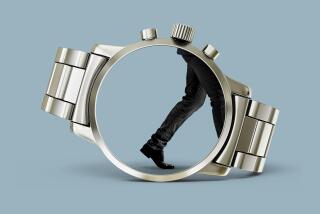Marking Time : Costa Mesa Man Turns Back the Clock on Pieces of History
- Share via
Time goes, you say? Ah no!
Time stays; we go.
--Austin Dobson, (1840-1921), English essayist-poet
With the possible exception of the light bulb, no object is as omnipresent in our lives as the clock.
Kitchen clocks, radio clocks, automobile clocks, alarm clocks, digital clocks, desk clocks, time clocks, wall clocks, cuckoo clocks, grandfather clocks, office clocks, clocks on the microwave, on the kitchen range, and on the VCR. There’s even an atomic clock, the most accurate timepiece in the world, that regulates oscillations taking place in individual atoms.
Not to mention the biological clock.
Literally billions of clocks quietly and not-so-quietly answering our near-psychotic need to know exactly what time it is at precisely any moment of the day.
In value, most aren’t worth the time of day, but a few--the time-tested ones, in particular--stagger the imagination for what they bring.
Like the 17th-Century English-made Thomas Tompion tall clock (no, they’re not grandfather clocks, but we’ll get into that later) that sold for a cool $3 million at auction several years ago in London. Or the 17th-Century American-made Simon Willard tall clock that brought $440,000 recently in Maine.
Obviously, it’s not timekeeping qualities that establish high prices for clocks; even the cheapest dime-store variety probably keeps as accurate if not better time than most antiques. So, what’s the difference?
“Mainly originality and authenticity,” answers Joe Lyons, a certified appraiser and dealer in new and antique clocks who owns a shop on Newport Boulevard in Costa Mesa.
Availability also plays a large role, he says, pointing out that “about 90% of the great European clocks” from the past “were destroyed in the two world wars.”
But to Lyons, who also repairs and restores clocks, they aren’t mere machines anyway; they are precious objets d’art-- “pieces of history.” His, or any other collector’s role for that matter, is “to act as a caretaker . . . to preserve them for future generations,” he says.
A normally brusque man, Lyons becomes amazingly mellow when talking about the inner workings of clocks from a bygone age. “They were made by real craftsmen who took enormous pride in their work,” he says. “You can even find very intricate designs in places that only a repairman would ever see.
“And they all signed their work, not with names, although some did, but with their individual styles.”
Their precision, he says, “is amazing” and testimonials to the craftsmanship of their makers. “After all,” he points out, “these have been running for several hundred years. I doubt very much anything built today will even be around 200 years from now.”
Not that he has anything against new clocks (about half his large shop is devoted to modern clocks, ranging up to $12,000 in price), but if all you’re interested in is the correct time, his feeling is that you should buy a watch.
“You want to buy a piece of history?” he asks as he gently removes a strange-looking glass-topped device from a locked cabinet. It’s a German lamp from the 1790s by which you could tell time (sort of) by the level of whale oil in it. The glass bulb, which has a wick at the bottom, has hour levels marked on its metal frame, like the yard markings on a football field. As the oil burns, the level drops, theoretically an hour in 60 minutes.
Of course, you would have to know the time when you lit the wick, and even then it would only be handy if your interest is in an approximation of the hour. It has no minute markings.
Or how about this Louis XIV-style clock encased in brass-inlaid tortoise shell?
“These are more than timepieces,” says Lyons. “They are art, they are history and they are exceptional investments.” Good antique clocks, he says, appreciate 10% to 15% per year.
And for some reason--possibly, he says, a lack of knowledge or appreciation--antique clocks sell for less on the West Coast than in other areas. “The prices go up as you move eastward,” he says, “about double in New York and triple by the time you get to Europe.”
But he’s quick to warn that “there are a lot of fakes out there,” and he’s not just talking about outright copies. Any clock’s value is diminished, he says, when the mechanism has been tampered with, when new parts have been used to keep it running.
“Original case, original parts--these are the keys to maintaining the value of an antique,” he says. “Don’t replace anything; repair it.”
And don’t buy anything without having it thoroughly checked out by an expert. “Even the auction houses don’t vouch for the authenticity of clocks,” he warns. Of course, there are exceptions, as with the $440,000 Simon Willard model, which came with its original bill of sale.
As for new clocks, as expensive as good ones are, most are bought as furniture, as something to attractively fill a space, he says. There’s nothing wrong with that, Lyons stresses, but too often buyers don’t remember that clocks are machines--”like automobiles”--that require service and maintenance.
As a result, he says, most new clocks seldom last beyond four to seven years no matter how good the inner workings. So, he makes it a practice to issue the following set of rules to the buyer:
* Don’t ever move the hands backward, only clockwise.
* Always remove the pendulums before moving a clock.
* Secure all clocks to protect them in case of earthquake.
* Don’t touch any of the mechanism when the clock is chiming.
* Provide periodic service, such as oiling.
* Have the clock cleaned every five years.
Although Lyons carries a large stock of “grandfather” and “grandmother” clocks, he is loath to use those terms. “If you were to ask a European clockmaker for a grandfather clock, he would think you’re talking about his grandfather’s clock,” he says.
Just for the record, in the vernacular, grandfather clock refers to pendulum-and-weight operated clocks standing higher than five feet; grandmothers are the same clocks standing less than five feet.
“Those are uniquely American terms that were born in the 1920s and came from a popular song, ‘My Grandfather’s Clock.’ (You know, the one that starts, ‘My grandfather’s clock was too tall for the shelf, so it stood 90 years on the floor.’) The correct term is tall clock or long-case clock. “
The terms are used to describe a type of clock whose origins are actually traced to Galileo, who first theorized about the timekeeping qualities of the pendulum in 1582. It was another century before the theory was put into practice and a Dutch astronomer, Christiaan Hugens--the most revered name in clockmaking--put it to the test and devised the first pendulum-operated clock.
What we now know as the grandfather clock was put into its current form in 1670, when English clock master William Clement introduced a second pendulum and encased the mechanism in wood.
Another feature, if you can call it that, of tall-case clocks is that all of the older models--and most of the new--must be manually wound once a week to operate.
No big problem, unless--like Lyons--you own several hundred of them.
More to Read
Sign up for Essential California
The most important California stories and recommendations in your inbox every morning.
You may occasionally receive promotional content from the Los Angeles Times.













